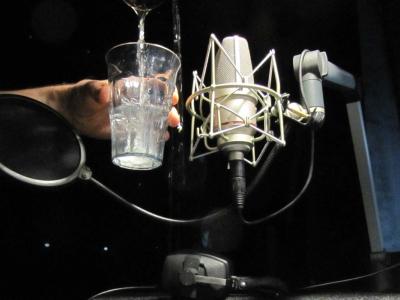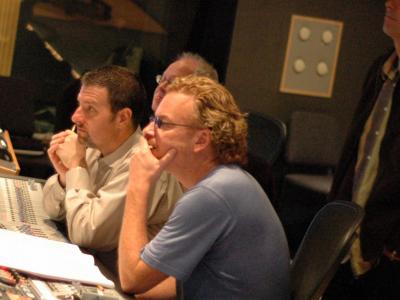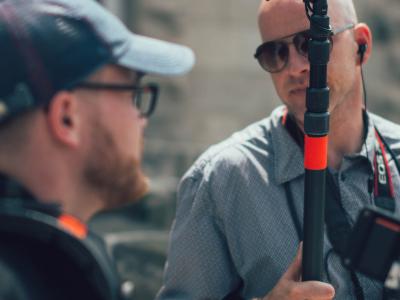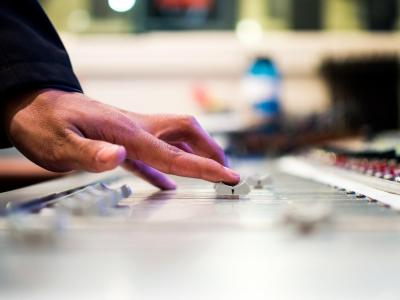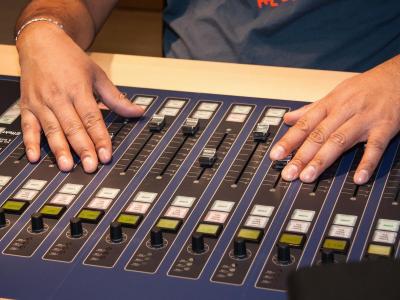This course takes your mixing skills to the next level and includes a thorough exploration of stereo, surround, and immersive mixing, and delivery-to-client specifications. We will explore advanced reverb applications, as well as techniques to mix different sample libraries with live recordings. You will do extensive listening to prepare your aural analysis skills prior to implementing these techniques in your own mixes. We will also address when, why, and how to engage a professional mix engineer. You will learn how to “mix to the dub” and develop sensitivity to the ultimate needs of the final film mix.
By the end of the course, you will be able to:
- Create stem mixes (submixes)
- Efficiently design and customize DAW templates for stem creation
- Listen critically to film music mixes
- Use reverb, delay, and other processing effectively for various mixing situations
- Effectively mix multiple different sample libraries with live recordings
- Deliver to specs, including 5.1 and other surround delivery formats
- Mix so that the music contributes optimally to the final film mix experience
Syllabus
Lesson 1: Mixing: A Brief History and “The Art”
- The “Art” (or the Craft) We Call “Mixing”
- Invoking Reality
- A Sort of History of the Mix
- Mixing the Film Score: Technology, Processes, and Economics
- Is This It? The Problem of Assessing a Mix
- Mixing One’s Music: Some Questions to Remain Objective
- Assignment 1: Cue Mixes: Self-Assessment
Lesson 2: How to Mix: Sonic Metaphors
- Mix Metaphor No. 1: Divide the Pie
- Mono
- Phase or Polarity?
- Mix Metaphor No. 2: Fusion vs. Separation
- Mix Metaphor No. 3: The Lead Goose—Mix Hierarchy
- Mix Metaphor No. 4: Visualizing the Frequency Spectrum
- Assignment 2: Mono Set Up and Mix Metaphors Analysis
Lesson 3: EQ: A Surgical Pie-Knife
- Surgery for the Simple
- EQ Types
- Special Case: Band Pass Filters
- Wielding the Scalpel in the Midrange
- Identifying the Culprit
- Pushing Your Track off the Cliff
- Assignment 3: EQ Practice and Analysis
Lesson 4: You Are Hear: The Effect of Your Workspace on Your Mix
- Your Writing Room: The Most Influential Piece of Mix Equipment You Have
- Assessing and Improving Your Listening Environment
- About Bass
- Your Speakers: You Want Love from Them!
- Reference Tracks Playlist
- About Subwoofers
- Headphones: Your Own Little World
- Assignment 4: Listening Analysis and Reference Tracks
Lesson 5: EQ: Now It’s a Paintbrush
- EQing in Color
- Low Frequencies: Sharing the Space
- Who’s the Boss of the Low End?
- High Frequencies
- Special Case: Tilt EQ
- Hearing the Frequency Spectrum: Tricks and Tips
- EQ is Tone, EQ is Volume
- The Midrange Boost
- Characteristics of EQ Plug-Ins
- Linear Phase vs. Minimum Phase EQ
- Assignment 5: More EQ Practice and Analysis
Lesson 6: The Orchestra: Live, Sampled, or Both?
- Orchestras: The Layout
- Recording Sections Separately: Strings and Woodwinds
- Recording Sections Separately: Brass and Percussion
- All Together Now?
- “Striping”
- The Real Orchestra: Wow! That’s a Lot of Microphones!
- Spot Microphones
- Orchestral Miking
- Percussion: Flexibility Is Needed
- Mixing the Live Orchestra
- Improving “Realism” in Your Sample Orchestra
- Assignment 6: Room and Spot Microphones—Volume and Panning
Lesson 7: Levels, Metering, and Automation
- Tech Roundup
- Three Kinds of Level Meters
- Assessments Using Metering
- Sample Rates and Bit Depth
- Going Deeper on Audio Levels
- Calibrating Ourselves
- The Most Common Cause of Flashing Red Lights at the Output
- Overview of Channel Automation: Automating in Pro Tools
- Checkerboarding
- Two Approaches to Track Automation: Drawn and “Performed”
- Understanding Mix Modes
- VCA Faders and Controlling Faders in Groups
- Surfaces and Tablets
- Assignment 7: Applying Metering and Automation
Lesson 8: Power and Energy: Compression, Limiting, and Saturation
- Compression as an Expressive Tool
- Timbre, Power, and Energy: A Listening Tour to Compression
- Compression in Film Scores
- Limiters
- Peak Limiter Controls
- Let’s Get Loud with Limiters
- Low-Frequency Impact: EQ and Enhancement Way Down Low
- Saturation and Other Evidence of Loud Things Happening
- Assignment 8: Applying Compression and Limiting
Lesson 9: Reverb and Ambience: Impressionism vs. Realism
- Reverb in Real Life
- Types of Reverb: Chambers, Springs, and Plates
- Reverbs: Continue the Listening Tour
- Digital Reverbs
- Layered Reverb and the Orchestra
- Delay Effects
- Mixing with Effects
- Assignment 9: Reverb
Lesson 10: Mixing to Stems
- The Slices of the Pie
- Stems and the Evolving Mix Template in Pro Tools
- Mix Templates in Cubase and Logic Pro
- What about Them Slices
- Keeping Your Stem Mixes Sanitary
- Dealing with the Sum
- Parallel Processing on Stems
- The Wrapping Means as Much as the Gift
- Assignment 10: Stems
Lesson 11: Tech Redux, Delivery, and QC
- Where Is My Data?
- External Drives and Data Security
- Backing Up
- File Transfer Services
- Sending Tracks to a Mixer
- Mockups and Versions—Danger!
- Levels Revisited: Limiting and Maximizing in a Score Mix
- Tech Getting in the Way—Troubleshooting
- Delivery to the Dub Stage
- Assignment 11: Deliver Professional Assets to a Score Mixer
Lesson 12: Upgrades, Expansion, and Into Surround
- The Professional Composer’s Studio
- Beyond Stereo—Surround
- Dolby Atmos and Object-Based Audio
- The Mixing Mindset
- Composers’ Assistants—Care and Feeding
Requirements
Ready to submit an unofficial copy of your transcript?
Submit TranscriptPrerequisites and Course-Specific Requirements
Prerequisite Courses, Knowledge, and/or Skills
Completion of OCOMP-507: Orchestral Mockups in Film Scoring or equivalent knowledge and experience is required.
Graduate level skill and understanding of film scoring is required. Students should be able to demonstrate advanced facility in their DAW of choice (Pro Tools, Cubase Pro, Logic Pro, or Digital Performer). If not using Pro Tools as your primary DAW, a working knowledge of Pro Tools is also essential.
Take the Mixing the Film Score self-assessment to determine your level.
Textbook(s)
- No textbooks required
Media and Subscriptions
- Tidal subscription
Software
- One of the following Digital Audio Workstations (DAW):
- Pro Tools 2018.12 or higher (First, Intro, and Artist editions are not sufficient)
- Cubase Pro
- Logic Pro
- High-quality algorithmic reverb, such as:
- LiquidSonics Cinematic Rooms
- iZotope Exponential Audio R4, Symphony, or Stratus
- ValhallaDSP Room
- Lexicon Native PCM Reverb Bundle
- Note: Altiverb (industry-standard convolution reverb) can be used in lieu of an algorithmic reverb.
Hardware
- Audio interface
- Studio monitors (pair), such as JBL 305Ps or better, as well as necessary cables. Monitors with 8-inch woofers are recommended, such as JBL 308Ps or better.
- iLok USB required to use Pro Tools offline. iLok Cloud (free) may be used instead, but requires a continuous internet connection while using Pro Tools.
Important Technical/System Considerations
- Your computer must be powerful enough to run large film scoring sessions smoothly. You should consider:
- At least 32 GB memory. 64 GB or more recommended.
- Recent Apple M-series Pro (e.g. M2 Pro), Intel Core i7, AMD Ryzen 7, or better processor.
- Note: The entry-level M-series Apple Silicon (e.g. just M1 or M2) is not sufficient, but we highly recommended a Mac equipped with an M-series Max or Ultra chip for this program.
- NVME M.2 SSD primary internal drive (or Apple Silicon)
- We recommend storing sample library content in a secondary internal or external SSD with 1 GB/s or higher read rates. Alternatively, you may opt for a Gigabit network solution, such as Vienna Ensemble Pro and secondary computer.
Student Deals
After enrolling, be sure to check out our Student Deals page for various offers on software, hardware, and more. Please contact support@online.berklee.edu with any questions.
General Course Requirements
Below are the minimum requirements to access the course environment and participate in Live Classes. Please make sure to also check the Prerequisites and Course-Specific Requirements section above, and ensure your computer meets or exceeds the minimum system requirements for all software needed for your course.
Mac Users
PC Users
All Users
- Latest version of Google Chrome
- Zoom meeting software
- Webcam
- Speakers or headphones
- External or internal microphone
- Broadband Internet connection
Instructors
Author & Instructor
Grammy-winner John Whynot's first major feature-film score mixing credit was The Last of the Mohicans, which won the 1993 Academy Award for sound. He has since mixed and programmed dozens of feature film scores, including Austin Powers I and II, Ronin, Stigmata, and The Breadwinner.
A composer and songwriter, his original compositions have appeared in feature films, television movies, national advertising and video games. He has extensive experience in all musical idioms and styles.
His Grammy- and Juno-award-winning career as a producer/engineer includes projects with Dave Matthews, Lucinda Williams, Blue Rodeo, Kathleen Edwards, Loreena McKennitt and Colin James
A multi-instrumentalist, he has appeared on stage or television with Bruce Cockburn, The Band, Rick Danko, Garth Hudson, Doug Sahm, Amos Garrett, Kathleen Edwards, Carole Pope, Corey Hart, Blackie & the Rodeo Kings
In his hometown of Toronto, where he was constantly seen on stage playing in literally dozens of bands (guitar, keyboards, saxophones), John frequently found himself in the producer’s chair in the studio. He was driven by a fascination with recording and an increasingly obvious talent for working the boards.
His move to Los Angeles in 1989 spurred a shift into film scoring. Within a short time he was brought into a project with composer Trevor Jones, who immediately hired him to program synths and mix the score to The Last of the Mohicans. Being a mixer who can read scores and relate to musicians as a musician has kept him working in film music ever since. He has also mixed and/or programmed scores for George S. Clinton, Elia Cmiral, Andrew Gross, Jeff Danna, Mychael Danna, John Debney and others.
In 2014, John accepted an offer to become an Associate Professor at Berklee College of Music in its vaunted Music Production and Engineering Department. He is now dividing his time between teaching and mixing in Boston and producing and mixing in Los Angeles.
Recently, John has been mixing album projects for B3-Berlin, Blackie & the Rodeo Kings, JW JONES, mixing the scores to the Amazon series The Last Tycoon and the Netflix mini-series Alias Grace and the feature films The Breadwinner and The Man Who Invented Christmas for Mychael Danna & Jeff Danna. He is also creating a new Minor in Audio Post Production at Berklee College of Music. Read Less
What's Next?
When taken for credit, Mixing the Film Score can be applied towards the completion of these related programs:
Related Certificate Programs
Related Degree Majors
Questions?
Contact our Academic Advisors by phone at 1-866-BERKLEE (U.S.), 1-617-747-2146 (INT'L), or by email at advisors@online.berklee.edu.


